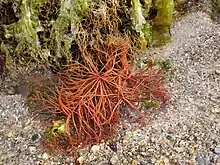Gracilariaceae
The Gracilariaceae is a small family of red algae containing several genera of agarophytes.[1] It has a world-wide distribution.[1] 24 species are found in China,[2] and 6 species are found in Great Britain and Ireland.[3] It is found in Australia and Chile.[4]
| Gracilariaceae | |
|---|---|
 | |
| Gracilaria algae at Concarneau in Bretagne (France) | |
| Scientific classification | |
| (unranked): | Archaeplastida |
| Division: | Rhodophyta |
| Class: | Florideophyceae |
| Order: | Gracilariales |
| Family: | Gracilariaceae Carl Nägeli, 1847 |
They are normally found in intertidal bays, back waters and estuaries.[5]
The family have been extensively investigated over the last 30 years, and various studies have yielded comprehensive information on their life history, cultivation, taxonomy, and utilization (Bellorin et al. 2002, Rueness 2005). Studies on the structure of their reproductive organs and the phylogenetic relationships among species inferred from rbcL sequence analyses have produced three clades at the genus level, namely Gracilaria, Gracilariopsis, and Hydropuntia (Gurgel and Fredericq 2004).[1][6]
In 2012, the University of São Paulo, Brazil set up the Gracilariaceae Germplasm Bank, to use molecule markers for the identification of species.[7]
Genera
- Crassiphycus Guiry, J.N.Norris, Fredericq & Gurgel, 2018 (7)
- Curdiea Harvey, 1855 (3)
- Graacilaria (1)
- Gracilaria Greville, 1830 (122)
- Gracilariophila Setchell & H.L.Wilson, 1910 (2)
- Gracilariopsis E.Y.Dawson, 1949 (17)
- Hydropuntia Montagne, 1842 (13)
- Melanthalia Montagne, 1843 (3)
Figures in brackets are approx. how many species per genus.[8]
Uses
They are economically important,[9] as Agar can be derived from many types of red seaweeds,[4] including those from families such as Gelidiaceae, Gracilariaceae, Gelidiellaceae and Pterocladiaceae. It is a polysaccharide located in the inner part of the red algal cell wall. It is used in food material, medicines, cosmetics, therapeutic and biotechnology industries.[10][11]
References
- Gurgel, Carlos Frederico D.; Fredericq, Suzanne (February 2004). "SYSTEMATICS OF THE GRACILARIACEAE (GRACILARIALES, RHODOPHYTA): A CRITICAL ASSESSMENT BASED ON RBCL SEQUENCE ANALYSES". Journal of Phycology. 40 (1): 138–159. doi:10.1111/j.0022-3646.2003.02-129.x. S2CID 85949879.
- Yang, Mi Yeon; Dong, Jun-De; Kim, Myung Sook (2012). "Taxonomic notes on five species of Gracilariaceae from Hainan, China". Algae. 27 (3): 175–187. doi:10.4490/algae.2012.27.3.175.
- Francis Bunker, Juliet A. Brodie, Christine A. Maggs, Anne R. Bunker Seaweeds of Britain and Ireland: Second Edition (2017), p. 82, at Google Books
- Byrne, Kellie; Zuccarello, Giuseppe C.; West, John; Liao, Ming-Long; Kraft, Gerald T. (December 2000). "Gracilaria species (Gracilariaceae, Rhodophyta) from southeastern Australia, including a new species, Gracilaria perplexa sp. nov.: Morphology, molecular relationships and agar content". Phycological Research. 50 (4): 295–311. doi:10.1111/j.1440-1835.2002.tb00162.x.
- Ambati Ranga Rao and Gokare A. Ravishankar (Editors) Sustainable Global Resources of Seaweeds Volume 2: Food, Pharmaceutical and ... ( ), p. 56, at Google Books
- Yang, Mi Yeon; Dong, Jun-De; Kim, Myung Sook (2012). "Taxonomic notes on five species of Gracilariaceae from Hainan, China". Algae. 27 (3): 175–187. doi:10.4490/algae.2012.27.3.175.
- Q. Ashton Acton (Editor) Issues in Applied Psychology: 2013 Edition, p. 122, at Google Books
- "Gracilariaceae". www.gbif.org. Retrieved 5 August 2022.
- Yang, Mi Yeon; Kim, Myung Sook (2015). "Molecular analyses for identification of the Gracilariaceae (Rhodophyta) from the Asia–Pacific region". Genes & Genomics. 37 (9): 775–787. doi:10.1007/s13258-015-0306-1. S2CID 256072302.
- Richard Koplik, Karel Cejpek and Jan Velisek The Chemistry of Food (2020), p. 296, at Google Books
- Mohammed Kuddus and Roohi (editors) Bioplastics for Sustainable Development (2021), p. 317, at Google Books
Other sources
- Bellorin AM, Buriyo A, Sohrabipour J, Oliveira MC, Oliveira EC (2008) Gracilariopsis mclachlanii sp. nov. and Gracilariopsis persica sp. nov. of the Gracilariaceae (Gracilariales, Rhodophyceae) from the Indian Ocean. J Phycol 44:1022–1032
- Conklin KY, O'Doberty DC, Sherwood AR (2014) Hydropuntia perplexa, n. comb. (Gracilariaceae, Rhodophyta), first record of the genus in Hawaii. Pac Sci 68:421–434
- Kamiya, M., Lindstrom, S.C., Nakayama, T., Yokoyama, A., Lin, S.-M., Guiry, M.D., Gurgel, F.D.G., Huisman, J.M., Kitayama, T., Suzuki, M., Cho, T.O. & Frey, W. 2017. Rhodophyta. In: Syllabus of Plant Families, 13th ed. Part 2/2: Photoautotrophic eukaryotic Algae. (Frey, W. Eds), pp. [i]–xii, [1]–171. Stuttgart: Borntraeger Science Publishers. ISBN 978-3-443-01094-2.